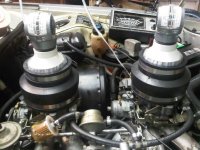Screw 1
I suggest all things in moderation;
Turn counterclock wise the one carb that is hissing the loudest, then clockwise on the least or quieter carb until you can get an idle below 950 or so.
Turn screws 2 and 3 by the same amount inward or clockwise by 1/4 turn also.
Once you can run at that speed, the adjustments are very small at a time while pausing to see the result.
Once that can be done, then a length of hose and listening to a fixed point of each carb and comparing is the method of balancing. If you have an air measuring device it is useful also.
The factory recommends two other methods- carefully count screw 2 and 3 turns inward to stop. The engine should be able to run at 6-700 rpm, then adjust screws 3 to obtain the same hiss or balance. Once that is done, the the screws 2 and 3 can be turned outward from the point that they were.
The other is to just use the screws 3 and idle at 850-950.
You're choice.
But again the idle needs to come down a little more than 1100 for balance.
Keep asking and I'll do my best to help.
I suggest all things in moderation;
Turn counterclock wise the one carb that is hissing the loudest, then clockwise on the least or quieter carb until you can get an idle below 950 or so.
Turn screws 2 and 3 by the same amount inward or clockwise by 1/4 turn also.
Once you can run at that speed, the adjustments are very small at a time while pausing to see the result.
Once that can be done, then a length of hose and listening to a fixed point of each carb and comparing is the method of balancing. If you have an air measuring device it is useful also.
The factory recommends two other methods- carefully count screw 2 and 3 turns inward to stop. The engine should be able to run at 6-700 rpm, then adjust screws 3 to obtain the same hiss or balance. Once that is done, the the screws 2 and 3 can be turned outward from the point that they were.
The other is to just use the screws 3 and idle at 850-950.
You're choice.
But again the idle needs to come down a little more than 1100 for balance.
Keep asking and I'll do my best to help.





